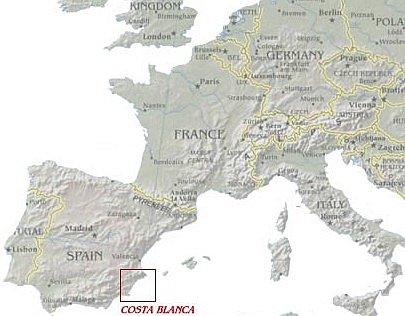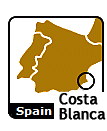Spain

Spain, or the Kingdom of Spain, is a country located in southwestern Europe on the Iberian Peninsula. Its mainland is bordered to the south and east by the Mediterranean Sea, except for a small land boundary with Gibraltar; to the north by France, Andorra, and the Bay of Biscay; and to the west by the Atlantic Ocean and Portugal. Spanish territory also includes the Balearic Islands in the Mediterranean, the Canary Islands in the Atlantic Ocean off the African coast, and two autonomous cities in North Africa, Ceuta and Melilla, that border Morocco. With an area of 504,030 km², Spain is the second largest country in Western Europe after France.
Spain is a constitutional monarchy, with a hereditary monarch and a bicameral parliament, the Cortes Generales. The executive branch consists of a Council of Ministers presided over by the President of Government (comparable to a prime minister), proposed by the monarch and elected by the National Assembly following legislative elections.
The legislative branch is made up of the Congress of Deputies (Congreso de los Diputados) with 350 members, elected by popular vote on block lists by proportional representation to serve four-year terms, and a Senate (Senado) with 259 seats of which 208 are directly elected by popular vote and the other 51 appointed by the regional legislatures to also serve four-year terms.
Climate
Due to Spain's geographical situation and orographic conditions, the climate is extremely diverse; discounting the mountain climate, it can be roughly divided into five areas:-
* Spain's climatic areas (except Canary Islands)A Continental Mediterranean climate in the inland areas of the Peninsula (largest city, Madrid).
* An Oceanic climate in Galicia and the coastal strip near the Bay of Biscay or (largest city, Bilbao). This area is often called Green Spain.
* A Semiarid climate or arid Mediterranean in the southeast (largest city, Murcia).
* A Mediterranean climate region extends from the Andalusian plain along the southern and eastern coasts up to the Pyrenees, on the seaward side of the mountain ranges that run near the coast. Also in Ceuta and Melilla (largest city, Barcelona).
* A Subtropical climate in the Canary Islands and some areas in the coast of Granada and Málaga (largest cities, Las Palmas de Gran Canaria, Santa Cruz de Tenerife and Motril).
The rain in Spain does not fall mainly in the plain: it falls mainly in the northern mountains!
People
The Spanish Constitution of 1978, in its second article, recognises historic entities ("nationalities", a carefully chosen word in order to avoid the more politically charged "nations") and regions, within the context of the Spanish nation. For some people, Spain's identity consists more of an overlap of different regional identities than of a sole Spanish identity. Indeed, some of the regional identities may even conflict with the Spanish one. Distinct traditional regional identities within Spain include the Basques, Catalans, Galicians and Castilians, among others.
It is this last feature of "shared identity" between the more local level or Autonomous Community and the Spanish level which makes the identity question in Spain complex and far from univocal.
Minority groups - Spain has a number of descendants of populations from former colonies (especially Equatorial Guinea) and immigrants from several Sub-Saharan and Caribbean countries have been recently settling in Spain. There are also sizeable numbers of Asian immigrants, most of whom are of Chinese, Indian, Filipino, Middle Eastern and South Asian origins; the population of Latin Americans(who can also be of Spaniard descent) is sizeable as well and a fast growing segment. Other growing groups are Britons, 760,000 in 2006, Germans and other immigrants from the rest of Europe.
The arrival of the Gitanos, a Romani people, began in the 16th century; estimates of the Spanish Gitano population fluctuate around 700,000. The Mercheros (also Quinquis) are a minority group, formerly nomadic, that share a lot of the way of life of Gitanos. Their origin is unclear.
Immigration to Spain - According to the Spanish government there were 4.5 million foreign residents in Spain in 2007; independent estimates put the figure at 4.8 million people, or 11% of the total population. According to residence permit data for 2005, about 500,000 were Moroccan, another 500,000 were Ecuadorian, more than 200,000 were Romanian, and 260,000 were Colombian. Other sizeable foreign communities are British (8%), French (8%), Argentine (6%), German (6%) and Bolivian (3%). Spain has more than 200,000 migrants from West and Central Africa. Since 2000, Spain has experienced high population growth as a result of immigration flows, despite a birth rate that is only half the replacement level. This sudden and ongoing inflow of immigrants, particularly those arriving clandestinely by sea, has caused noticeable social tension.
Within the EU, Spain has the second highest immigration rate in percentage terms after Cyprus, but by a great margin, the highest in absolute numbers. There are a number of reasons for the high level of immigration, including Spain's cultural ties with Latin America, its geographical position, the porosity of its borders, the large size of its underground economy and the strength of the agricultural and construction sectors, which demand more low cost labour than can be offered by the national workforce.
Another statistically significant factor is the large number of residents of EU origin typically retiring to Spain's Mediterranean coast. In fact, Spain was Europe's largest absorber of migrants from 2002 to 2007, with its immigrant population more than doubling as 2.5 million people arrived. According to the Financial Times, Spain is the most favoured destination for West Europeans considering a move from their own country and seeking jobs elsewhere in the EU.
The number of immigrants in Spain has grown up from 500,000 people in 1996 to 5.2 million in 2008 out of a total population of 46 million. In 2005 alone, a regularisation programme increased the legal immigrant population by 700,000 people. Unemployment among immigrants has risen 67% in 2007. Spain's new Plan of Voluntary Return encourages immigrants to leave Spain for three years and offers up to €25,000, but so far, only 186 Ecuadorans have signed up to return. In the program's first two months last year, just 1,400 immigrants took up the offer.







